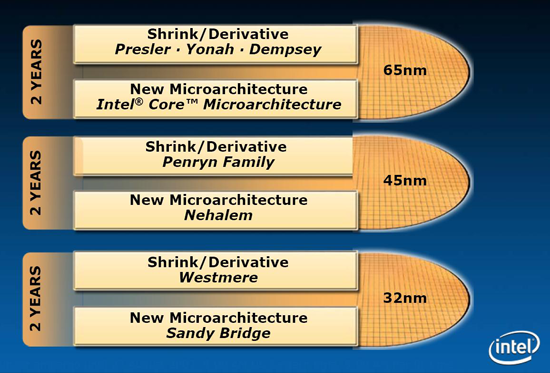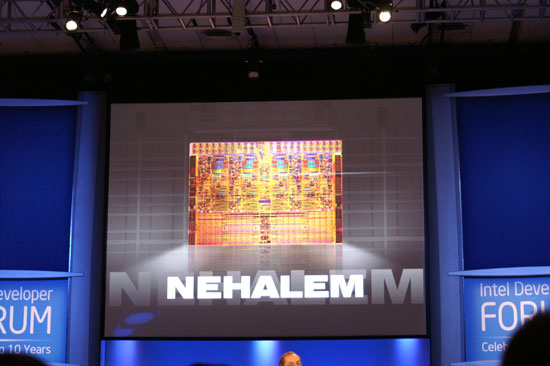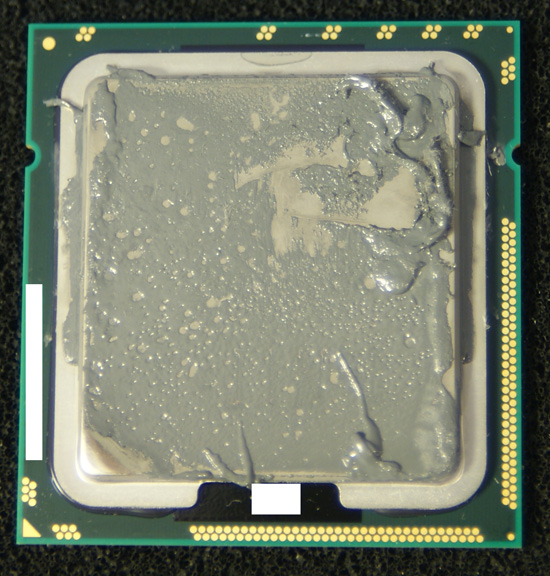The Nehalem Preview: Intel Does It Again
by Anand Lal Shimpi on June 5, 2008 12:05 AM EST- Posted in
- CPUs
Two years ago in Taiwan at Computex 2006 Gary Key and I stayed up all night benchmarking the Core 2 Extreme X6800, the first Core micro-architecture (Conroe core) CPU we had laid our hands on. While Intel retroactively applied its tick-tock model to previous CPU generations, it was the Core micro-architecture and the Core 2 Duo in particular that kicked it all off.
At the end of last year we saw the first update to Core, the first post-Conroe "tick" if you will: Penryn. Penryn proved to be a nice upgrade to Conroe, reducing power consumption even further and giving a slight boost to performance. What Penryn didn't do however was shake the world the way Conroe did upon its launch in 2006.

After every tick however, comes a tock. While Penryn was a die shrink of an existing architecture, Nehalem is a brand new architecture built on the same 45nm process as Penryn. It's sort of a big deal, being the first tock after the incredibly successful Core 2 launch.

731M transistors, four cores, eight threads
It's like clockwork with Intel; around six months before the release of a new processor, it's sent over to Intel's partners so they may begin developing motherboards for the chip. It was true with Northwood, Prescott, Conroe, Penryn and now Nehalem. And plus, did you really expect, on the eve of the two year anniversary of our first Core 2 preview, a trip to Taiwan for Computex without benchmarks of Nehalem? In the words of Balki Bartokomous, don't be ridiculous :)

Yep, that's what you think it is
Without Intel's approval, supervision, blessing or even desire - we went ahead and snagged us a Nehalem (actually, two) and spent some time with them.
(Sorry guys, stop making interesting chips and we'll stop trying to get an early look at them :)...)










108 Comments
View All Comments
SiliconDoc - Monday, July 28, 2008 - link
Crysis- etc. :Pete, you can be very happy knowing it will do folding like mad, and you can fantasize that you've cured cancer while you spend your money for some tax subsidized already to the hilt University program, because you're such a good and loving person.
( I know YOU didn't mean anything like that - see sarcasm! )
In the mean time, the OLD HT single core chips will do just fine cranking most games, and dual core or core2duo or 2180 or some other then $40 chip will be a few percentage pts. shy.
My gawd, they've got our number.
I bet they "unlock it !!!!! " OMG ! for like 2 grand if you're cooooool you can get one!
Crank the Planet - Thursday, June 5, 2008 - link
I know it may be exciting but the article sounds fan-boyish. For most of the marks it shows what intel is claiming 20-30% boost. He gets one mark to go 50% and now it's 20-50% boost?? He compares in another mark AMD 21 and nehalem 14 and says it's almost 50% faster!!! and then compares penryn 18 and nehalem 14 and says it's 28%. I think the AMD mark was more like 35%.As I've said before everybody knows AMD was going to hurt themselves in the short run by buying ATI. If they didn't buy ATI I think things would be very different. Now that the last year of payments is being made for buying ATI AMD will be able to get back into the game.
Intel has only now integrated the memory controller. Everybody knew as soon as they did they would see a nice bump. They haven't had any significant innovations in a long time. AMD is in the same position they were before K8. Just give them some time to finish absorbing ATI, then watch out- fusion is just around the corner :)
hs635 - Tuesday, June 17, 2008 - link
Fuck off retardmasouth - Friday, June 6, 2008 - link
What kind of idiot fan-boy drivel is this?"He gets one mark to go 50% and now it's 20-50% boost??"
Ummm, yes?
1, 2, 3, 4, 8
What is the range of those numbers? 1-8, right?
Does the majority of them being being in the 1-5 range somehow negate the fact that the actual range is 1-8?
THINK PEOPLE!
michael2k - Thursday, June 5, 2008 - link
You're the one that sounds like a fanboy.What makes you think Intel's CPU-GPU integration won't be as fabulous as their IMC or quad-core components? Intel doesn't need "significant innovations" (nor does AMD), they just need higher performance, lower power, and lower cost, which is exactly what they have.
Innovations only exist to serve those aspects.
Justin Case - Sunday, June 8, 2008 - link
Wrong.AMD64 (the instruction set) isn't about "more performance". Virtualization isn't about "more performance". Hardware no-execute flags aren't about "more performance". SATA's hot-plug ability isn't about "more performance".
Your statement shows the kind of lack of vision that brought us the Pentium 4.
I for one am far more excited about technology that allows me to do something new or different than "technology" that simply lets me do the same stuff faster. 99% of CPU cycles in the planet go unused anyway.
zsdersw - Thursday, June 5, 2008 - link
Given the overall tone of your reply, the criticism of the article as "fan-boyish" is, really, the pot calling the kettle black.Visual - Thursday, June 5, 2008 - link
so you agree as well? yeah, me too.they are both black. they are both fanboys :)
zsdersw - Thursday, June 5, 2008 - link
I've said nothing about agreeing with anything. What I have said, though, is that a fanboy calling someone else a fanboy is perhaps not indicative of any objective truth.Jynx980 - Saturday, June 7, 2008 - link
It will be a great day when I can read any CPU discussion without the word fanboy in it.The close up of the chip has waaaaaay to much thermal compound on it.
Is it just me or is the first pic of the Intel roadmap rather... phallic?